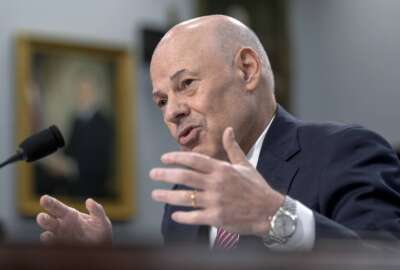Some persistent management challenges for HUD
"One of the main challenges that we focus on is capacity. So more people doing the work is a good thing," said Rae Oliver Davis.
For the Department of Housing and Urban Development, management challenges persist. In its annual review, HUD’s inspector general finds some progress. But also that eight of the top ten challenges remain from last year. We get an update on the Federal Drive with Tom Temin from IG Rae Oliver Davis.
Interview transcript:
Tom Temin And let’s start with the good news. You found that on these top ten challenges for this annual report, HUD has made some progress. Tell us where they did well.
Rae Oliver Davis Sure, absolutely. We try every year to reflect progress HUD is making. And I would say this year we’ve seen tremendous progress in human capital management. And of course, that’s not a challenge solely for the Department of Housing and Urban Development. That’s a challenge that we see SIGI reflect government wide. But what we’ve seen specifically at HUD is a reduction in time to hire by about 23% since FY 2020, which means they’re onboarding more people, which, one of the main challenges that we focus on is capacity. So more people doing the work is a good thing. They have a headcount of about 8,360. They had 8,347 in FY30. So this is the largest headcount in 10 years.
Tom Temin Right. And 23% in federal hiring terms is a couple of weeks or maybe a month off of the hiring process, maybe longer.
Rae Oliver Davis And we’ve seen this through them modernizing their policies. They’ve developed workforce planning, they’re doing more to track those activities. And the Office of Capital Management is doing a much better job, I think, of interfacing with the program offices, hearing their needs and getting people on board just faster.
Tom Temin Yeah. So that then in turn kind of helps the rest of the staff when the staffing that’s needed and authorized is actually there.
Rae Oliver Davis Absolutely. And human capital management, IT, things of that nature, we call those enterprise challenges. Because they certainly affect the operations, and then they ultimately greatly impact the mission. So it’s good to see this reduction in time to hire for sure.
Tom Temin And if you look at the list of best places to work in the federal government, HUD, this kind of middling, they’re not terrible, but they did rise a little bit from year-to-year, too.
Rae Oliver Davis Well, we haven’t looked specifically at their scores, but we’re certainly aware of them. And yeah, we find in general, the workforce is very dedicated to the mission at HUD.
Tom Temin Okay. And then some things did not come out quite so well improved, and promoting health and safety in HUD assisted housing top your list.
Rae Oliver Davis It does this tends to be an area of struggle for the department, I think in part, because it’s such a decentralized part of their mission, as is most of it if we’re talking about grants, talk about money that’s going through the department, we’re really looking at program partners. There’s over 3,000 public housing authorities. We have over 500,000 landlords participating in the voucher program. All of them have to be held to a health and safety standard. People living in HUD housing deserve to live in safe sanitary housing. We find that to be a great challenge for HUD and its oversight, whether we’re talking about lead, whether we’re talking about the inspections of these properties and holding those landlords accountable for remediating problems. It’s definitely an ongoing issue. And overall, it attributes to HUD’s challenge in increasing affordable housing. They have to maintain what they have.
Tom Temin In some ways, they have the challenge of just pick one out, McDonald’s making sure that its franchisees operate according to standards that the corporation wants.
Rae Oliver Davis Yes, absolutely. Recently we looked at the housing choice voucher program, which is where an individual beneficiary can take their voucher and go out to a landlord and have some choice in where they live. But we found that the inspections, the problems that were being pointed out to the PHAs who were overseeing the landlords in the voucher program, these things weren’t being held accountable. There wasn’t remediation. And in fact, when they knew things weren’t being done appropriately, they were still continuing to pay the landlords. So the contracts weren’t being abated, the payments weren’t stopping. So we have people living in substandard housing, even out in the voucher program.
Tom Temin So, in other words, even though HUD doesn’t go sweep the halls, and fix the refrigerators and so forth and housing, they do have leverage if they could somehow strengthen it.
Rae Oliver Davis They do. And look, it’s certainly incumbent upon me to say the biggest challenge is, if you have to relocate people, where do you put them? And we encounter that a lot. We have not just substandard housing, but we have just plain old bad actors. We have been doing, as you know, Tom, sexual harassment, sexual misconduct. We’ve been looking at that in the program landlords that just plain it victimize the beneficiaries and the tenants. And again, we want to get bad actors out. We want to hold people accountable. But there is a lack of affordable housing. There is a huge challenge when those contracts are abated and people have to be relocated.
Tom Temin And what’s your recommendation there in that area?
Rae Oliver Davis Well, frankly, we’re studying that right now. We’re looking at property pepper tree outside Memphis, Tennessee. It was a project based rental assistance program where all ultimately, HUD abated the contract, people had to be moved. And we know they’re working closely there with the community, but we’re studying the after effects of that to sort of better understand perhaps best practices, perhaps the challenges the community faces in those moments as well as the department. So I hope to have more on that. But it’s always going to be a challenge, I believe.
Tom Temin If they shut down a place, say, or withdraw support, fine, You’ve gotten rid of that landlord, but then you have the people to deal with and they have to have housing. That’s the central challenge here?
Rae Oliver Davis They have to have housing. Think about it if one of us were forced to move. Our families here, our friends are here, our jobs are here, our community is here, our churches are here, our schools are here. There’s everything about that that’s impacted. Another thing with relocation and abatement of contracts is if we’re talking about project based rental assistance, and we have to abate that contract. There are laws on the books that won’t enable them to go out and get more contracts. So if we see a building and the contract shuts down, we will not see a new building. That is simply the case. So they are limited in how many of those contracts they can maintain at any given time.
Tom Temin We’re speaking with Rae Oliver Davis, inspector general of Housing and Urban Development. And that’s external to HUD, even though it’s mission related. But there are also a lot of internal issues that are on their top ten list. Two of them relate, grants management and increasing effectiveness in procurement. So the two channels of outgoing money, grants and procurement, they need to tighten up.
Rae Oliver Davis Sure. The procurement challenge is one that we’ve really heard from the department officials themselves. And, Tom, we’ve changed the way we do these. We don’t just look at solely our work, we look at our colleagues at GAO. We talk to the department, we certainly read the news. We listen to your podcast. We talk to external stakeholders, including the Hill and all of the associations that deal with HUD. And one of the things that kept coming up was procurement, a lack of visibility around the process, maybe a lack of coordination between OCPO and the program offices, which would result sometimes in a lapse in contracts that do hold up the mission, do affect the operation. We’ve seen progress there. We’ve really focused on highlighting this one. And we see dashboards now where OCPO and the program offices can see where contracts are beginning and ending. They can see the status of a procurement. I think the next phase for us is looking at contract performance, and that’s something you’ll see from us in the future. But absolutely, procurement has made the radar for us the last few years based predominantly on HUD principles. And look, if we’re talking about grants management, that is the name of the game HUD’s grants. Everything is coming out in a grant. One thing we’re hoping for there, is more transparency in the data because we want to go beyond just compliance and we want to look at performance. We want to see how are these grants really impacting the communities. Are they doing what they’re supposed to do? So we’re looking to HUD to really collect better data. And if we’re talking about grants, we’re not just talking about the grantee. This is a very decentralized process at HUD. And it has to be, I think, because it has to go out to the community. So we have grantees, sub-grantees, contractors, and that there’s just a long line of places that money has to go. We have to track that data, we have to understand it.
Tom Temin Yeah, that’s a good point, because sometimes a grantee will turn around and let contract, and you would think that they would be doing that competitively by best value and so forth. But it’s not a federal contracting. It’s somebody out there doing it.
Rae Oliver Davis Well, most times they’re contracting, they’re subcontracting it, and using and subrecipients. That’s something that we see quite a bit with disaster relief. We’ve seen it with everything, frankly, in HUD’s portfolio. And for us, in the IG community, those of us that really are going after the bad actors, the further it takes the money to go out the door and to reach where it’s supposed to be, the more apt we are to see fraud, mismanagement. We don’t have that data, it’s really impossible becomes impossible to track that money.
Tom Temin For example, you might want to have some database to match the money with entities and therefore you could find out if a grantee is giving contracts in turn to its brother in law.
Rae Oliver Davis Absolutely. And we get allegations of that now, but with better data, we could identify red flags quicker and we could get to this problem faster.
Tom Temin And I wanted to ask you about something on the list, which I don’t know the meaning of, mitigating counterparty risk.
Rae Oliver Davis So that’s a sophisticated way of talking about, is HUD dealing with the lenders? Are they looking at the investors in [Government National Mortgage Association (GNMA)] Ginnie Mae? Are they the issuers? Again, there are program partners that have to help them carry out the mission. Lenders have to make the loans. We have a million HUD programs out there, not a million, but we have quite a few. It’s really complex that benefit first responders, teachers, first time homebuyers. Lenders have to come out with those programs, execute them, and HUD relies on them to underwrite those loans. So are they looking at the eligibility? We have identified a remarkable amount of money that’s at risk, because we are insuring loans to ineligible individuals, whether they have back taxes, federal debt, child support payments that are backed up, that sort of thing. So we’re looking for HUD to that counterparty risk. If we’re talking about Ginnie Mae, we’re talking about specifically really on banks that are in the programs. For years, we had big lenders with deposits that were regulated. This independent mortgage bank in surge that we’ve seen at the partner level with FHA and Ginnie Mae identifies a group of people that aren’t regulated. They don’t rely on deposits. They rely on refinancing. They rely on third party financing. And if we see an uptick in interest rates, we see a little bit less of that. And so they become a little bit more at risk. And departments addressing that, they see that. We’ve talked about that. They’ve talked about it publicly. But that’s what we mean by counterparty risk. Lenders, issuers.
Tom Temin Got it. And in general, HUD management accepts this report and agrees that these are issues it has to work on. They’re not stonewalling you.
Rae Oliver Davis Goodness, no. In fact, I would say year after year, we have gotten more and more positive feedback on the top management challenges. It’s certainly due in part to, frankly, talking to them more, collaborate with them more, understanding their mission. I think this report in particular does a great job of showing how much we actually understand what’s going on at the department. We have just a sophisticated perspective, as do the people who are executing the policies of the programs at this point. And we share their concerns. And I think for the most part, we really line up in seeing this report as a true depiction of what’s going on at the department.
Copyright © 2024 Federal News Network. All rights reserved. This website is not intended for users located within the European Economic Area.
Tom Temin is host of the Federal Drive and has been providing insight on federal technology and management issues for more than 30 years.
Follow @tteminWFED






